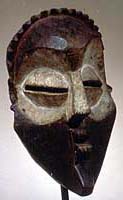
 Central African masks display a variety of styles, some of which are shared across regions and cultures as a part of continuing trade and political exchanges, such as between the Luba and Songye or the Kete and Mbagani peoples. Stylistic traits--the heart-shaped face is one example--found on works over a broad geographic range may testify to old migration patterns. Throughout the area copper alloy, cowrie shells, and other valuable materials suggest both wealth and spiritual protection. Central African masks display a variety of styles, some of which are shared across regions and cultures as a part of continuing trade and political exchanges, such as between the Luba and Songye or the Kete and Mbagani peoples. Stylistic traits--the heart-shaped face is one example--found on works over a broad geographic range may testify to old migration patterns. Throughout the area copper alloy, cowrie shells, and other valuable materials suggest both wealth and spiritual protection.
 Masks mark a variety of events throughout the cycle of life and death, and the concept of transformation is essential to their meaning. Donning a mask and costume and performing in a masquerade that includes the appropriate music, words, and ritual change the male performer into an ideal of feminine beauty, a personification of power, or a spiritual being. The carved white-faced masks of southern Gabon (pictured to the left), for instance, depict serene women. This expression contrasts with their performances at funerary rites, which are characterized by vigorously athletic stilt dances. Masks mark a variety of events throughout the cycle of life and death, and the concept of transformation is essential to their meaning. Donning a mask and costume and performing in a masquerade that includes the appropriate music, words, and ritual change the male performer into an ideal of feminine beauty, a personification of power, or a spiritual being. The carved white-faced masks of southern Gabon (pictured to the left), for instance, depict serene women. This expression contrasts with their performances at funerary rites, which are characterized by vigorously athletic stilt dances.
|
|
Pictured above (from top to bottom)
Mask (kibwabwabwa)
Kete or Mbagani peoples, Democratic Republic of the Congo
19th-20th century
Wood, kaolin, pigment
H. 28.3 cm (11 1/8 in.)
The Israel Museum, Jerusalem, gift of Lawrence Gussman, New York, to American Friends of the Israel Museum in memory of Dr. Albert Schweitzer, B97.0017
The masks of both the Kete and the Mbagani are notable for their concise, geometric forms. Among the Mbagani, the huge eyes are associated with the ancestral spirits they worship, and the masks are worn at rites to promote successful hunting or female fertility. The Kete use masks of a similar style in initiation rituals.
Face mask (mukudj)
Punu or Lumbo peoples, Gabon
First half of the 20th century
Wood, pigment, kaolin
H. 32.1 cm. (12 5/8 in.)
The Israel Museum, Jerusalem, gift of Lawrence Gussman, New York, to American Friends of the Israel Museum in memory of Dr. Albert Schweitzer, B97.0008
In the Ogowe River region, the Punu, Lumbo, and neighboring peoples create naturalistic, white-faced masks that convey idealized visions of womanhood. The diamond-shaped pattern on the forehead represents scarification, a marker of cultural identity. The masks, with their calm visages, were worn by skilled male dancers who regaled the audiences with wild acrobatics while performing on stilts.
Reliquary Guardian Figures | Masks of Gabon and the Congo | Status and Power | Divination and Spiritual Power | Figurative Sculpture | Beneath the Surface
Public Programs | Credits and Catalogue | Home
|



